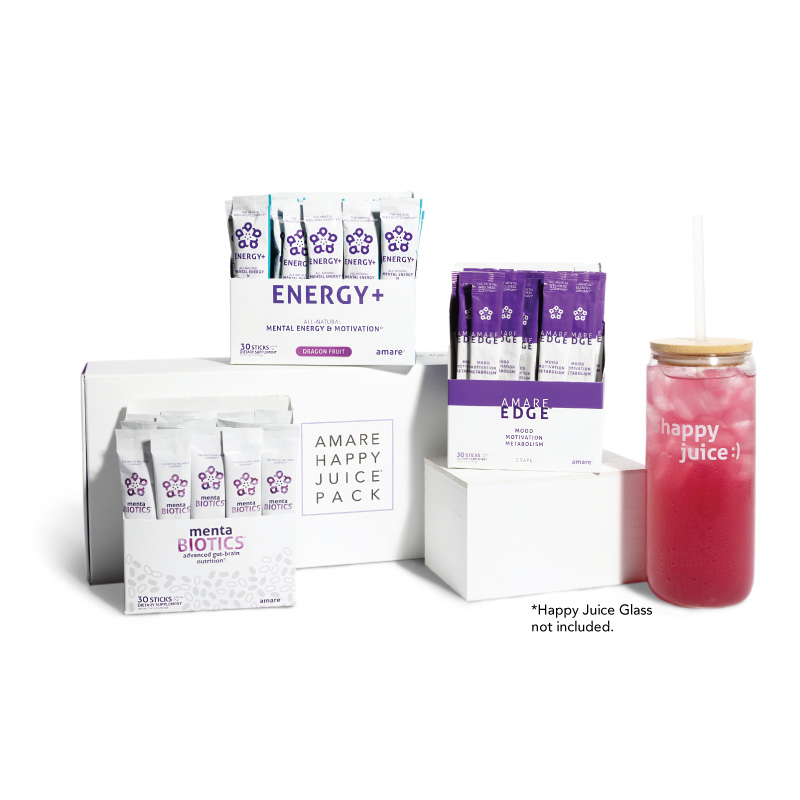Listen on: Apple Podcasts | Spotify
Health clubs and home gym equipment companies have always operated as separate, even competing, businesses.
In one model, you provide access to space and equipment for your customers. In the other model, you provide equipment for your customer’s space.
Unfortunately, no fitness company to date has built a business that offers both.
I felt this was an opportunity while working at my previous company. I even floated the idea described below by a few people at the time. Today, I feel confident that this is how to capitalize on the current social and economic environment and stand apart from all other membership-based fitness companies.

Feel Better Fast. Guaranteed.
Energy+, EDGE, and MentaBiotics make up the Happy Juice supplement stack, with ingredients clinically proven to:
- decrease anxiousness scores by 55%
- decrease irritability scores by 60%
- decrease fatigue by 64%
- decrease anger 54%
- decrease tension by 45%
- decrease confusion by 43%
- decrease overall distress by 49%
- increase good bacteria by 70%
- decrease negative mood by 105%
- increase positive mood by 211%
2020 Was a Wake-Up Call
This past year should be a wake-up call for health club operators around the world. National and local governments could close your business at any time, for as long as they can (un)reasonably justify.
Almost all health clubs lost money. Some closed completely. Thousands of fitness professionals found themselves on unemployment.
That’s not to say fitness was the only industry rocked by lockdowns. The lockdowns hurt many other businesses as well. Local and state governments are unnecessarily handcuffing some still today.
With fitness, though, there’s a certain irony. To protect yourself from COVID-19 and almost any other disease or infection, you need to be healthy. The best way to get healthy is to follow a well-designed fitness program, which you can do at a gym or health club.
Instead of promoting how to build a strong immune system and get healthy and fit, public health “experts” and politicians have only focused on wearing masks and getting vaccines. That nonsense probably won’t change.
As a result, millions of health club members floundered at home with bands, bodyweight movements, and pastel-colored dumbbells. You can only get results for so long with such a limited amount of equipment.
An opportunity has long-existed for the top health club operators to help people get fit at home like they do in their gyms.
A Better Model: The In-Club At-Home (ICAH) Fitness Business
For simplicity, I called this the In-Club At-Home Fitness Business. For more simplicity, I refer to it as ICAH, where appropriate.
A couple of notes before continuing:
Suppose I pitched this concept as a corporate employee or looking for funding from an investment group. In that case, I’d include a plethora of financial data and other stats as part of an official business plan. However, you only need to use common sense to understand the reality of the current problems, opportunities, and value of merging in-club and in-home fitness.
Though any company with enough funding could build an ICAH fitness business, I believe existing health club operators have a few distinct advantages:
- Existing membership, canceled membership, and prospective membership audience
- Existing equipment manufacturing relationships
- Sales and marketing teams that understand the consumers’ mindsets
- A local footprint to begin promoting the new part of their business
The ICAH business model combines:
- In-home equipment sales and leasing. For a health club to remain consistent with its exercise/training philosophies when guiding people in-club or at-home, it must provide a means for people to use similar equipment in either location. You can’t tell members that deadlifts and back squats are essential when they have access to the gym, and then tell them lunges and picking up grocery bags is good enough when they train at home.
- Access to online or app-based training programs. Numerous online training platforms already exist. If a company were to build their own platform, I wouldn’t expect it would be “cutting edge,” so it might be better to merge with an existing platform that allows trainers to work with multiple members and members or clients to get individualized programming or to participate as part of a group or team of people with similar goals.
- Traditional health club membership and online training membership. Though nothing compares to the camaraderie and companionship of in-person relationships at the club, we’ve learned to adapt to part of our life being online. Being a “member” doesn’t mean you have to walk into the club multiple times per week. It merely means you’re pursuing similar goals as other people, and you can train as they do.
Adding In-Home Fitness Equipment to an In-Club Membership Business
The stumbling block in executing the ICAH fitness business is not selling or leasing the right strength training equipment.
The stumbling block is in a health club operator getting over the fear that they’ll lose memberships if they help people work out at home.
If an investor or business owner clings to that belief, they’ll miss out on the opportunity to impact and engage a significant (and growing) part of the population.
More people work from home today than ever. They’re commuting less. Many are afraid of catching something from being around other people (not saying that’s a justifiable fear, but it’s a real fear of many).
To ignore the need for providing quality in-home equipment and quality in-home training programs is to neglect a significant business opportunity and a solution to a problem many people unknowingly face today.
Equipment Packages
Start with three strength training equipment packages. A baseline equipment package would include the following:
- Squat rack with adjustable safety pins, pull-up bar, and a few other optional attachments. The Hammer Strength HD Elite Multi Rack would be one example.
- Adjustable bench
- Barbell and Olympic plates (less likely to damage floors)
- Dumbbells up to 50 lbs, 75 lbs, or 100 lbs. with appropriate rack(s)
- Rubber flooring (baseline rubber flooring would be sufficient to outline workout space surrounding power rack area
Determine the minimum space necessary to set this equipment up, and include its schematics in the equipment package so potential customers understand how it would fit in their home, garage, or shed. You might even suggest in the advertising that neighbors chip in and share the costs.
Add no more than two upgraded packages, which could include a pulley attachment and cable attachments, a landmine, and heavy bands. Offering more than three choices leads to decision fatigue and a reduced chance people will make a choice.
Fortunately, any successful health club company already has relationships with quality equipment manufacturers. Many of those companies make lighter versions of their equipment for home use.
The equipment package might run $2000-$5000. If someone finances their purchase over 36-60 months, the monthly cost won’t be much more than their monthly membership dues.
Training Programs
Design training programs for your members based on the baseline list of equipment. That way, people can easily transition from workouts in the gym to workouts at home.
Most app-based training platforms make it easy to swap exercises during a workout as well, which would make it easy to swap out a leg press in the club for a barbell front squat at home.
The key is that those who workout at home should do almost the same training as those working out at the gym. This maximizes the number of people following the program, which creates a sense of community, camaraderie, and healthy competition.
Equipment Leasing, Sales, and Membership Inclusion
This is where the blending of a membership business and what’s historically been a one-time-purchase business come together.
How does the sale of strength training equipment add to your membership balance? Simple.
Each equipment package includes a one-year, club-access membership, and following that, four more years of your virtual or online membership. That’s a huge value-add for purchasing the equipment and adds minimal incremental expense for the health club since most people initially work out at home.
However, after several months, they may start seeing the value of getting into the gym and use it on occasion. The goal would be to get them using the club once or twice a week by the end of the first year and then continue their access membership.
By then, your member paid down at least some of the home-gym equipment and has the flexibility to workout at home when they need the convenience and at the gym when they want the community and variety.
If they choose not to continue with the access membership, you still work with them online for four years. You’ll probably get them using your recommended supplements and possibly adding additional home-gym accessories during that time.
There are two other components to this business model that warrant consideration. They also expand your value and potential audience.
First, an equipment leasing option should be in place. This allows more people to get started with the equipment at a lower monthly investment while still adding numbers to the membership base.
The second is an equipment buy-back and used equipment reselling opportunity.
Let’s face it, many people who buy home gym equipment don’t stick with using it. Some decide they prefer getting into the clubs. By offering a buy-back program, those who buy their equipment know that they’ll get at least some of their investment back if they ever decide to get rid of it.
The buy-back and leasing options also provide a used equipment sales opportunity for those who don’t want to pay full price for new equipment. Though there are some logistics involved with equipment transport, it’s more or less an inventory management sales process.
Each piece of equipment could conceivably be sold, bought back, and resold two or three times, each with a profit involved. Each sale includes a new membership as well.
A Note About the Training App
Online and app-based training platforms have been around since the beginning of the Internet. Early-to-market companies have been evolving their platforms ever since.
You probably won’t be able to build something better than what’s out there already, so you can learn from the existing platforms or possibly buy or lease one of them.
The app needs to be:
- easy for trainers to develop programs
- clear, simple, and fast for members to use
- track training history and performances like sets, reps, total volume, etc.
- create space for engagement with coaches and fellow members
- allows for competition among members on the same team or program. In my online training program, VIGOR Training, I incorporate a leaderboard into many training sessions, where athletes add the weight they used for an exercise or the total load they’ve lifted for a session to a leaderboard. This shows them who else is training as well as what’s possible based on what others accomplish.
Examples of ICAH Business At Play
Example 1: John is a member of the gym and is very committed to his training program. His Governor has a history of locking down the state, so he’s concerned that with another lockdown, he’ll be stuck with doing pushups, pull-ups, and kettlebell swings for weeks on end. He buys a basic ICAH Home Gym package and gets a year of his access membership dues credited after the sale. The health club does not lose anything by offering this, and John remains an active member whether the Governor closes gyms or not.
Example 2: Karen is afraid of going back to the gym, and can’t stand that her Governor won’t shut down all gyms, bars, and restaurants. That said, she still wants to train hard and wouldn’t even mind a friend or two coming over to workout on occasion. She calls her gym to cancel her membership and connects with Stephanie from membership sales. Stephanie tells Karen that the club now offers home gym sales and installation, and they deliver and install the equipment while following all necessary safety precautions. Karen realizes she can finance her equipment package for only $175 per month and can remain a member of the club at the same time. The best part is that the equipment will fit in her garage, so she can have a friend or two join her now and then. One of her friends even offers to chip in on the cost and adds an online membership to the club to get the same programming.
Example 3: Randy lives on a ranch, and the closest gym is a 20-minute drive. However, he’d like to get on a consistent strength training program and has space for the equipment. Rather than finding some mediocre program online, he’d like to work with someone more credible. He orders an ICAH Home Gym package and adds on a monthly video call with a personal trainer (another new offering that complements the business model) who gives him personalized nutrition and fitness guidance.
COVID’s Problems Created Opportunities For Those Willing to Embrace Them
Over the past 12 months, we’ve been primed and conditioned to fear COVID and believe home is the only safe place to be. The fitness industry now faces:
- Uncertainty of ability to operate business(es). Lockdowns, forced business closures, and government overreach will likely continue. What’s transpired over the past year set a precedence for how some personalities and political parties will handle public health concerns in the future. Other flu strains, coronaviruses, or bacterial infections may be met with the same fear-mongering and excessive attempts to prevent the spread.
- Reduced interest in going to or joining a gym or fitness center membership market. The media, public health “experts,” and politicians have conditioned people to believe public spaces create health risks, which will drive many people to exercise at home. It’s unlikely that fear-conditioned members will return to health clubs and will likely resort to home-based exercise if they exercise at all. This means a significant portion of health club members will not come back. It will be even worse the next time we encounter a “pandemic.”
- Inability for average person to train appropriately from home. The strength equipment at a gym provides a distinct advantage over bodyweight and band exercises. When a member has to transition from traditional strength equipment to bands and body weight, they inevitably lose strength, even if the workouts feel challenging. To get gym-like results at home, you need a small amount of gym equipment at home. Unfortunately, not one fitness center offers equipment or guidance on buying the equipment out of fear they’ll lose memberships.
- Reduced membership dues and personal training and ancillary product revenues. Many fitness companies depend on the revenues their personal trainers generate. Personal training, Pilates, or other individual and small-group programming add incremental revenue and EBITDA. The members who invest in these programs spend more in the clubs on ancillary products and services and are more likely to maintain their membership.
Why succumb to the effects of the culture shift when you can embrace it, build a more successful business than ever, and ultimately help more people achieve health and fitness than you could have with the old business model?
Final Comments
From my experience, getting something like this accepted within a corporate environment takes multiple meetings and discussions. Though I left out the answers to many questions people would ask for the sake of brevity, I would also expect some to ask questions I hadn’t considered.
If I worked for a fitness company, I’d prepare multiple versions of pitch decks and spreadsheet-heavy business plans as every decision-maker requires a different perspective on a proposal like this.
Since I don’t work for anyone but believe this is a viable, if not a game-changing concept, I decided to publish this as a blog post in hopes someone would take it and run with it.
Photo by Sven Mieke on Unsplash

Feel Better Fast. Guaranteed.
Energy+, EDGE, and MentaBiotics make up the Happy Juice supplement stack, with ingredients clinically proven to:
- decrease anxiousness scores by 55%
- decrease irritability scores by 60%
- decrease fatigue by 64%
- decrease anger 54%
- decrease tension by 45%
- decrease confusion by 43%
- decrease overall distress by 49%
- increase good bacteria by 70%
- decrease negative mood by 105%
- increase positive mood by 211%



